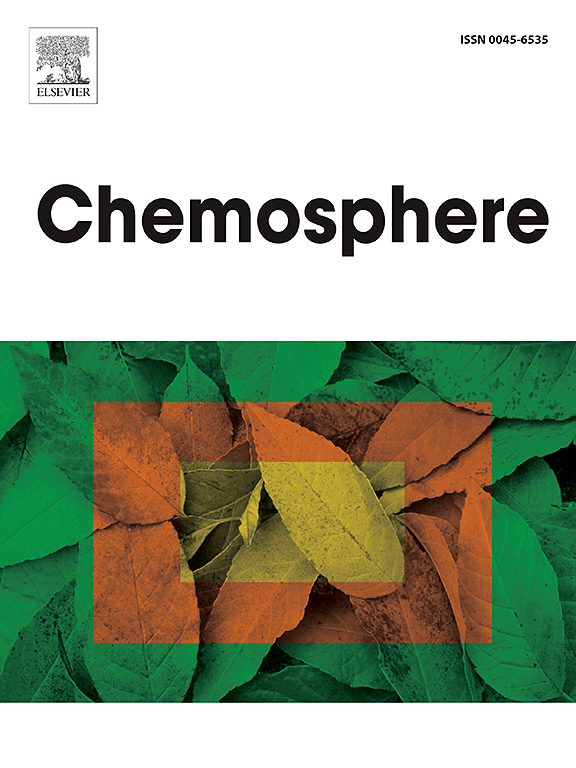Metallothionein as a biomarker of aquatic contamination in fish: An in silico and in vitro approach using zebrafish as experimental model organism
IF 8.1
2区 环境科学与生态学
Q1 ENVIRONMENTAL SCIENCES
引用次数: 0
Abstract
Human activities contaminate aquatic ecosystems with chemicals like metals and pesticides. Fish, sensitive to pollution, are key toxicological models. Metallothionein (Mt) expression, a biomarker for metal contamination, varies depending on the chemical exposure. This study investigated differences in metal affinity for Zn2+ binding sites of proteins and Mt induction by the insecticides dichlorvos (DDPV) and deltamethrin (DTM) in Danio rerio. First, D. rerio Zn-binding protein structures with different cell functions were used to evaluate the difference between the binding scores of five metals with the binding site with highest affinity for Zn2+ through molecular docking and from there to infer the most potent inducers. Cadmium ion was found to have the highest binding score mean for the selected proteins (Cd2+>Cu2+>Pb2+>Mn2+>Cu+>Hg2+), and, thus, cadmium chloride (CdCl2) was used as a positive control for Mt induction in D. rerio larvae. D. rerio embryos were exposed to sublethal concentrations of Cd (100 μg L−1), DDPV (1 mg L−1), and DTM (0.01 μg L−1) up to 96 h post-fertilization (hpf). Larvae exposed to Cd and DDPV showed increased Mt levels, whereas DTM exposure had no effect. Proteomic analyses suggest that Mt induction in D. rerio larvae exposed to Cd follows a distinct mechanism from DDPV exposure. Enrichment analysis supports a possible link between DDPV exposure and oxidative stress-induced Mt expression. In contrast, Cd-induced Mt expression likely involves metal transcription factor activation by Zn2+. These differences in responsiveness highlight the need for careful consideration when using Mt as a biomarker of metal contamination.

金属硫蛋白作为鱼类水体污染的生物标志物:以斑马鱼为实验模式生物的硅内和体外方法
人类活动用金属和杀虫剂等化学物质污染了水生生态系统。对污染敏感的鱼类是关键的毒理学模型。金属硫蛋白(Mt)是金属污染的生物标志物,其表达随化学物质暴露而变化。本研究研究了敌敌畏(DDPV)和溴氰菊酯(DTM)两种杀虫剂对斑马鱼蛋白质中Zn2+结合位点的金属亲和力和Mt诱导的差异。首先,利用不同细胞功能的D. rerio锌结合蛋白结构,通过分子对接,评估5种金属与Zn2+亲和力最高的结合位点的结合分数差异,进而推断出最有效的诱导剂。结果表明,镉离子对所选蛋白(Cd2+>Cu2+>Pb2+>Mn2+>Cu+>Hg2+)的结合得分平均值最高,因此可以将氯化镉(CdCl2)作为幼虫诱导Mt的阳性对照。胚胎在受精后96 h暴露于亚致死浓度的Cd (100 μg L−1)、DDPV (1 mg L−1)和DTM (0.01 μg L−1)中。暴露于Cd和DDPV后,Mt水平升高,而DTM对Mt水平无影响。蛋白质组学分析表明,暴露于Cd的裂谷夜蛾幼虫的Mt诱导机制与暴露于DDPV的机制不同。富集分析支持DDPV暴露与氧化应激诱导的Mt表达之间的可能联系。相反,cd诱导的Mt表达可能与Zn2+激活金属转录因子有关。这些响应性的差异突出了当使用Mt作为金属污染的生物标志物时需要仔细考虑。
本文章由计算机程序翻译,如有差异,请以英文原文为准。
求助全文
约1分钟内获得全文
求助全文
来源期刊

Chemosphere
环境科学-环境科学
CiteScore
15.80
自引率
8.00%
发文量
4975
审稿时长
3.4 months
期刊介绍:
Chemosphere, being an international multidisciplinary journal, is dedicated to publishing original communications and review articles on chemicals in the environment. The scope covers a wide range of topics, including the identification, quantification, behavior, fate, toxicology, treatment, and remediation of chemicals in the bio-, hydro-, litho-, and atmosphere, ensuring the broad dissemination of research in this field.
 求助内容:
求助内容: 应助结果提醒方式:
应助结果提醒方式:


